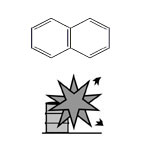| Case Name |
Explosion in dead space of a reactor at a naphthalene oxidation plant |
| Pictograph |

|
| Date |
February 4, 1987 |
| Place |
Kawasaki, Kanagawa, Japan |
| Location |
Chemical factory |
| Overview |
An explosion occurred at a mixer in a plant that manufactured naphthoquinone and phthalic anhydride through the oxidization of naphthalene by air. Three rupture disks were scattered and some debris flew into an adjacent workplace. There were no injuries. A non-volatile component of the raw material accumulated in a dead-end piping in air piping, and formed a low-temperature ignitable substance by oxidation. It is presumed that it ignited by accumulating oxidation heat, then the naphthalene-air mixture ignited and exploded. Hazard study was insufficient, and maintenance management of the facilities was defective. |
| Incident |
An explosion occurred at a mixing chamber in a manufacturing unit that oxidizes naphthalene in air, and produces naphthoquinone and phthalic anhydride. Three rupture disks were scattered, and debris flew to an adjacent workplace. |
| Processing |
Manufacture |
| Individual Process |
Reaction |
| Process Flow |
Fig2.Unit process flow
|
| Chemical Reaction |
Oxidation |
| Substance |
Naphthalene, Fig3 |
| Type of Accident |
Explosion |
| Sequence |
This unit was constructed in 1973, and was remodeled with two trains (A and B) in 1987. Train A, which caused the accident, was added in April, 1986. Train A was shut down three times after start-up, and overhauls of an air duct and a mixer, which had a possibility of tar adhesion, were carried out. At that time, the tar was not removed completely. It was only scratched off. Train A operated as usual before the accident. About 9:16, on February 4th, 1987, an explosion occurred in the lower part of the mixer. All three rupture disks between the mixer and the reactor broke, and the debris was dispersed. |
| Cause |
Non-volatile components included in the naphthalene jetted in the mixer fell along a wall and accumulated in dents in the air pipe under the mixer. It is considered that they oxidized and formed a low-temperature ignitable substance. It was not cooled because this part was a dead end piping in the air flow, As a result, oxidation heat accumulated, and the material ignited. It is presumed that the mixture of air and naphthalene vapor evaporated from comparatively fresh un-oxidized tar ignited and exploded. Refer to Fig2. |
| Response |
An interlock operated, and the naphthalene supply pump stopped. The air supply stopped after 20 seconds, and the plant stopped automatically. |
| Countermeasures |
The dead-end piping in air piping was removed.
The equipment is checked once every three months, and tar is removed by incineration once every six months.
A rupture disk with a slit is used to prevent the dispersion of rupture disks. |
| Knowledge Comment |
Material like tar that adheres to equipment such as piping raises the hazard of forming a low-temperature ignitable material due to long-term oxidation.
Unnecessary material adhering to or contaminating equipment might cause an accident.
Although a liquid is sprayed, all the parts do not become uniform minute particles. Some of them recombine and become big particles, and impurities that are solid, or have different viscosity or density might become different particles. |
| Background |
Study on hazards of the equipment structure was insufficient. Consideration of hazards related to dead end piping and behavior of liquid after atomization was lacking. The adhering tar was cleaned so that blockage should not spoil product properties. However, the hazard of tar accumulating was not considered. It is thought that maintenance management of equipment was insufficient. |
| Incidental Discussion |
A dead space such as the dead end of piping often causes various problems. |
| Reason for Adding to DB |
Example of explosion caused due to heat accumulation from oxidation of atomized liquid because of an inadequate piping shape |
| Scenario |
| Primary Scenario
|
Organizational Problems, Poor Management, Slackness of Management, Poor Value Perception, Poor Safety Awareness, Inadequate Risk Recognition, Insufficient Analysis or Research, Insufficient Prior Research, Structure of Equipment and Danger based on It, Planning and Design, Poor Planning, Poor Design, Usage, Maintenance/Repair, Insufficient Cleaning, Bad Event, Chemical Phenomenon, Heat Generation, Secondary Damage, External Damage, Explosion
|
|
| Sources |
Fire fighting station, Peace section of the Kawasaki City. Norio Tsujimoto, Explosion at naphthalene oxidation reaction facility, 35th national fire fighting engineer conference paper (1987).
|
| Physical Damage |
Three rupture disks and an earth screen were damaged. A naphthalene injection nozzle, two thermometers of the thermocouple type, and a frame arrester of the reactor inlet side were deformed. |
| Financial Cost |
¥ 1 million (National Fire Research. Inst. conference paper). |
| Multimedia Files |
Fig3.Chemical formula
|
| Field |
Chemicals and Plants
|
| Author |
OGAWA, Terushige (Graduate School of Environment and Information Sciences, Yokohama National University)
TAMURA, Masamitsu (Center for Risk Management and Safety Sciences, Yokohama National University)
|
|